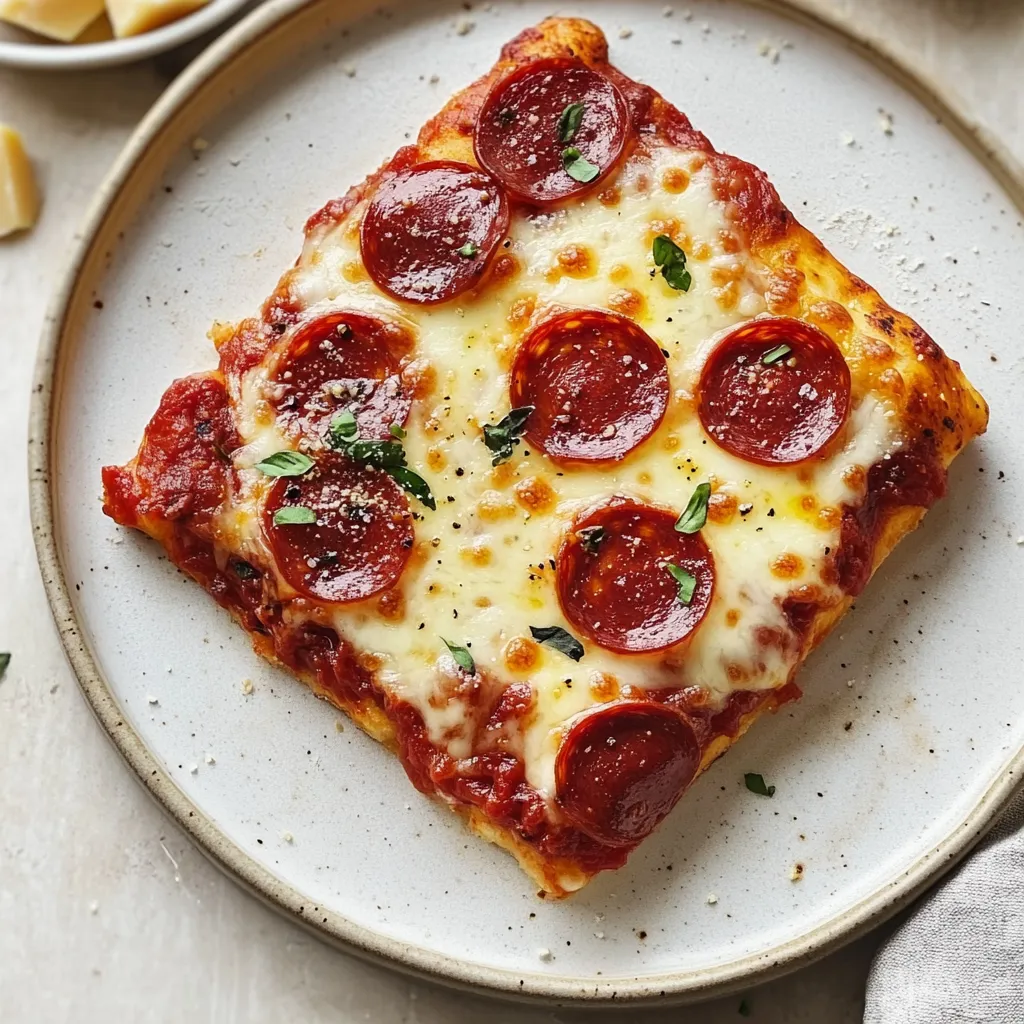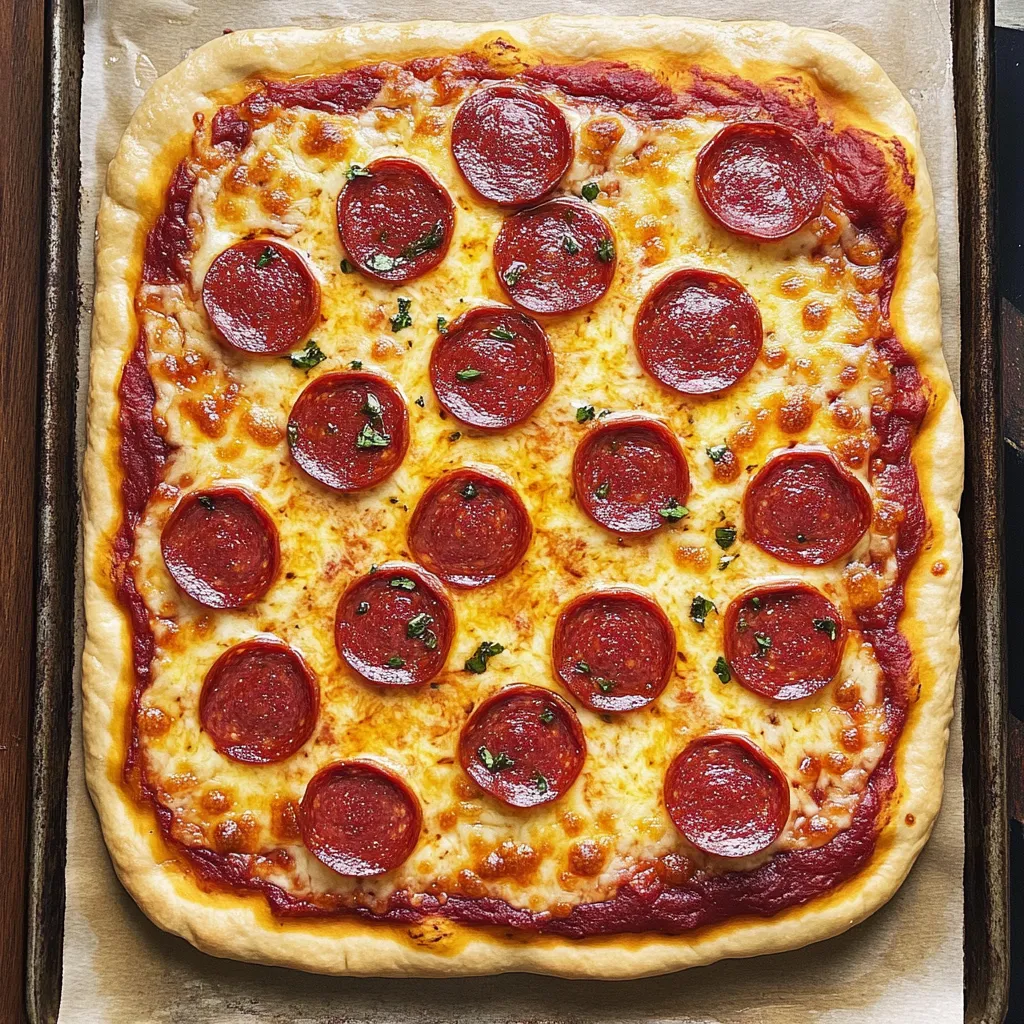 Pin it
Pin it
This exceptional pepperoni pizza recipe creates restaurant-quality deep dish pizza at home with a perfectly crispy yet chewy crust, tangy homemade sauce, and just the right balance of melted cheese and savory pepperoni. The homemade pizza dough develops incredible flavor through proper rising time, while the secret ingredient balsamic vinegar in the sauce adds depth that sets this pizza apart from ordinary versions. Using a rimmed baking sheet instead of specialty equipment makes this accessible for any home cook who wants to create impressive pizza without investing in expensive tools.
I started making this pizza when my family was spending way too much money on delivery pizza that never quite lived up to our expectations. The first time I made homemade pizza dough, I was amazed at how much better it tasted than anything we'd ordered, and the kids got so excited watching it rise and helping with the toppings. Now pizza night is one of our favorite family traditions, and I love how making it from scratch turns dinner into an event. The smell of fresh pizza baking in the oven creates this amazing atmosphere that brings everyone into the kitchen, and the results are so much better than delivery.
Essential Ingredients and Selection Tips:
- Bread flour: Higher protein content creates better gluten development for chewy, structured crust; all-purpose works but bread flour is superior
- Instant yeast: Also called rapid-rise yeast; more reliable and faster-acting than active dry yeast
- Quality crushed tomatoes: Choose tomatoes with basil for extra flavor; San Marzano varieties provide the best taste
- Fresh garlic: Essential for authentic flavor; garlic powder won't provide the same depth and aroma
- Good pepperoni: Choose thick-cut, high-quality pepperoni that won't become greasy during baking
- Cheese combination: Provolone and fontina create better flavor and melting than basic mozzarella alone
Step-by-Step Instructions:
- Create the perfect pizza dough:
- In the bowl of a stand mixer fitted with a dough hook, combine bread flour, granulated sugar, instant yeast, and salt, mixing briefly to distribute evenly. Add warm water (110-115°F) and olive oil, then knead on medium speed for 8 minutes until the dough forms a smooth, elastic ball that clears the sides of the bowl. The dough should be slightly sticky but not wet, and should stretch without tearing when pulled gently.
- Prepare for first rise:
- Generously coat a rimmed half-sheet pan with olive oil, making sure to cover the bottom and sides completely. This oil is crucial for creating the crispy bottom crust that makes this pizza special. Transfer the dough to the oiled pan and turn it to coat all surfaces. Cover with another inverted half-sheet pan and let rise in a warm, draft-free location for about 90 minutes, until doubled in size.
- Prepare the signature pizza sauce:
- While the dough rises, heat olive oil in a medium saucepan over medium heat. Add minced fresh garlic and red pepper flakes, cooking for 30 seconds until fragrant but not browned. Add crushed tomatoes, a pinch of sugar, salt, and the secret ingredient - a splash of balsamic vinegar. Simmer for 15-20 minutes, stirring occasionally, until the sauce thickens slightly and the flavors meld together beautifully.
- Preheat oven for optimal baking:
- At least 20 minutes before baking, preheat your oven to 475°F. This extended preheating time ensures the oven reaches proper temperature and the heating elements stabilize, which is crucial for achieving the crispy crust and properly melted cheese that characterize great pizza.
- Shape dough for deep dish style:
- Once the dough has doubled, use your fingers to gently press and stretch it to fit the entire surface of the baking sheet, reaching all corners and edges. Don't use a rolling pin, which would deflate the dough. Work from the center outward, being gentle to maintain the airy texture. Cover again and let rest for 30 minutes for the final rise.
- Assemble with perfect proportions:
- Spread the cooled pizza sauce evenly over the dough surface, leaving a small border around the edges for the crust. Distribute the sliced provolone cheese evenly, followed by cubes of fontina cheese for superior melting and flavor. Top with pepperoni slices, spacing them evenly to ensure every bite gets the perfect amount.
- Bake to golden perfection:
- Place the pizza in the preheated oven and bake for 18-20 minutes, until the crust is golden brown around the edges and the cheese is bubbly and starting to brown in spots. If the top browns too quickly, reduce temperature to 450°F and continue baking until the bottom crust is properly crispy.
- Cool and serve properly:
- Remove from oven and let the pizza cool for 3-5 minutes before cutting. This brief cooling period allows the cheese to set slightly, making cleaner cuts and preventing all the toppings from sliding off. Cut directly in the pan using a pizza wheel or sharp knife, and serve immediately while hot.
 Pin it
Pin it
The ingredient I'm most excited about in this recipe is definitely the balsamic vinegar in the pizza sauce. When I first read about adding balsamic vinegar to pizza sauce, I thought it sounded weird, but it makes such an incredible difference. That tiny splash adds this amazing depth and subtle sweetness that balances the acidity of the tomatoes perfectly. It's one of those secret ingredients that makes people taste your pizza and wonder what makes it so much better than ordinary pizza sauce. The vinegar doesn't make the sauce taste sweet or vinegary - it just creates this complex, restaurant-quality flavor that transforms the entire pizza.
Dough Development and Gluten Formation
The success of this pizza lies in proper dough development through adequate kneading and rising time. Bread flour's higher protein content creates stronger gluten networks that produce the characteristic chewy yet tender texture of great pizza crust. The 8-minute kneading time in a stand mixer develops the gluten properly, while the long rise allows flavors to develop and the dough structure to strengthen, resulting in a crust that's both flavorful and texturally superior.
Oil Technique and Crust Development
The generous oil coating on the baking sheet serves multiple crucial purposes beyond preventing sticking. The oil conducts heat efficiently to the bottom of the dough, creating the crispy, golden crust that makes this pizza special. It also adds flavor and helps achieve that perfect contrast between the crispy bottom and tender interior that defines excellent pizza. This technique mimics what professional pizza ovens achieve through high heat and proper surface preparation.
Sauce Balance and Flavor Complexity
Creating exceptional pizza sauce requires understanding how different ingredients contribute to overall flavor balance. The combination of garlic, tomatoes, and balsamic vinegar creates layers of flavor that complement rather than compete with the cheese and toppings. The brief cooking time concentrates flavors while maintaining the bright tomato taste, and the sauce consistency should coat the dough without being so wet that it makes the crust soggy.
Cheese Selection and Melting Properties
Using a combination of provolone and fontina instead of standard mozzarella creates superior flavor and texture in the finished pizza. Provolone provides sharp, tangy notes while fontina contributes creamy richness and excellent melting properties. This combination creates the stretchy, flavorful cheese layer that makes each bite satisfying while avoiding the bland, rubbery texture that often results from using low-quality mozzarella.
Temperature Control and Baking Technique
Achieving perfect pizza requires understanding how oven temperature affects different components of the pizza. The high initial temperature creates rapid crust development and proper cheese browning, while the option to reduce temperature prevents burning if the top browns too quickly. The 20-minute preheating period ensures consistent heat distribution that cooks the pizza evenly from bottom to top.
Make-Ahead Strategies and Storage
Both the dough and sauce components of this pizza can be prepared in advance, making pizza night more convenient and allowing flavors to develop further. The dough actually improves with refrigerated storage up to 24 hours, developing more complex flavors through slow fermentation. Understanding proper storage and reheating techniques ensures you can enjoy homemade pizza with minimal day-of preparation.
This pepperoni pizza recipe has become the cornerstone of our family's weekly routine because it brings everyone together while creating something infinitely better than anything we could order. There's something magical about the process of making pizza from scratch - from watching the dough rise to the incredible aroma that fills the house while it bakes. Every time we make it, I'm reminded that some of the best family memories are created around simple activities like cooking together, and the results taste so much better when everyone has helped create them. It's become proof that taking a little extra time to make things from scratch doesn't just improve the food - it improves the entire experience.
Frequently Asked Questions
- → Can I make the pizza dough ahead of time?
- Yes, you can make the dough up to 24 hours ahead. After the first rise, cover tightly and refrigerate. Let it come to room temperature before shaping.
- → What if I don't have a stand mixer?
- You can mix by hand, but it takes more effort. Mix ingredients in a large bowl, then knead on a floured surface for 10-12 minutes until smooth.
- → Can I use different cheeses instead of provolone and fontina?
- Sure! Mozzarella works great, or try a mix of mozzarella and parmesan. Use about 14 ounces total cheese for best coverage.
- → How do I know when the pizza is done baking?
- The cheese should be bubbly and golden, and the crust edges will be golden brown. This usually takes 18-20 minutes at 475°F.
- → Can I freeze leftover pizza?
- Yes, wrap cooled slices individually in plastic wrap, then freeze for up to 3 months. Reheat in a 350°F oven for best results.
- → Why is my dough so sticky to work with?
- The high moisture content makes sticky dough, which creates a better crust. Lightly oil your hands when handling instead of adding more flour.
